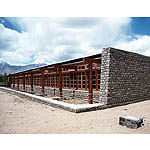For the past 15 years, Simone Swan has been on a crusade to promote adobe. Over the years, she established a foundation to teach construction techniques, built a demonstration house in Ojinaja and appealed to governments and lenders to fund housing programs for the poor.
Juana Briones Historic House

Juana Briones was known as a healer who raised a big family, opened her door to many in need and persevered to win a divorce from an abusive husband — something unheard of in the early 1800s. In 1844 she bought the 4,400-acre Rancho La Purisima Concepcion and lived there until not too long before her death in 1889. What Briones advocates have been trying to do for several years now is preserve the part of the house that’s built of a very unusual construction called encajonado, an old rammed-earth technique that exists in only three other houses in California. On the Juana Briones Heritage Foundation Website, the house is described as Palo Alto’s oldest, with a construction date of 1846. In May a judge is expected to issue a decision that will make the difference between a house repaired and a house demolished.
Split House

Located in the mountains of northern Beijing by the Great Wall, the Split House is designed by perhaps China’s most internationally acclaimed architect, Yung Ho Chang of Beijing’s first private architecture practice, Atelier Feichang Jianzhu. The house is split in the middle to bring in the scenery. A courtyard, or outdoor living area, is enclosed by the mountains on one side and the house, with its two split halves, on the other. The line between the natural landscape and manmade architecture is thus blurred. The angle between the two halves can be adjusted to fit the house onto various hill sites. The structure is made of laminated wood with rammed earth walls, which is well insulated with minimum environmental impact.
Earthquake Devestates Morrocco
Thousands of homeless Moroccans struggled to rebuild their lives after a powerful earthquake that killed nearly 600 people forced survivors to spend the night in the open. Hopes dimmed of finding any more people alive in the rubble of devastated mud-brick homes in villages scattered around the Mediterranean port city of Al Hoceima. The quake, measuring 6.5 on the Richter scale, struck early on Tuesday as many people were sleeping in their houses.
Call for Papers and Conference Announcement
The Second Annual Conference of the Adobe Association of the Southwest will take place May 21, 22 and 23 in El Rito, New Mexico on the campus of Northern New Mexico Community College.
Call for Papers Schedule:
One page (maximum) abstract due March 23, 2004
Notification of acceptance March 31, 2004
Full paper (5-page maximum) due April 23, 2004 for conference prepublication.
Presenters will have 20 minutes for presentation and 10 minutes to answer questions. Time limits will be carefully monitored.
The host institution can accomodate 2×2 slides in Carousels or Microsoft PowerPoint Presentations.
Topics of special interest are:
Affordable adobe construction
Thermal properties of earthen materials
Historical buildings of note in the United States
Historical builders of note in the United States
Historical architects/designers of note
Historical developers/planners of note
New projects
Adobe education
Manufacture and supply of construction materials
Conference Schedule:
Friday, May 21, 2004
11AM to 1PM Registration
1:30PM to 4:30 PM Session I
5PM to 6:30PM Dinner
7PM to 9PM Social Hour
Saturday, May 22, 2004
9:30AM to 12M Session II
1:30PM to 5PM Tour
7PM to 9PM Session III
Sunday, May 23, 2004
9:30AM to 12M Session IV
Northern New Mexico Community College has dorm rooms, suites, and a cafeteria available at very reasonable prices. Contact Donald Martinez for reservations at 505-581-4120 or donmart@mail.nnmcc.edu
The Conference registration cost is $30 for Association members and $45 for non-members. For more information contact Quentin Wilson at 505-581-4156 or qwilson@mail.nnmcc.edu
Implements for Pisé or Rammed Earth Buildings
Rammed Earth University Cottages
Wide-eyed and inquisitive, 25 first-year students moved into Charles Sturt Universitys residential rammed-earth cottages in Thurgoona, Australia. The Student Pavillion, which was the first new building, laid the foundation for demonstrating and gaining acceptance of an environmental design approach to the further development of the Thurgoona campus.
Clay – The Eternal Stuff Of Building
Mud is almost too basic to talk about, but humans have used it for more than 15,000 years to build things, so its value is inestimable. And, since most clay is free – there’s no commercial market (outside of artists’ specialty clays) competing for your dollars.
Texas Rammed Earth/South Carolina Origins
Southwest School of Art & Craft, with roots dating to 1848, when the Catholic community started building the Ursuline Academy, an elite, private girl’s school, it is one of the oldest education sites in San Antonio, Texas. It was recently declared the largest and most significant example of French-influenced architecture in the state by the French Heritage Society. Early buildings on the campus were designed by famed architect Francois Giraud, the city’s first surveyor who is responsible for many of the city’s distinct buildings, including the French Gothic style addition of San Fernando Cathedral. Giraud, who was born in South Carolina to French immigrant parents, chose a construction method called pise de terre, or rammed earth, for the buildings. Skilled pise worker Jules Poinsard worked as a subcontractor on the project.
Arup Engineers Mud Brick

Architecture Week reports that since 1997, engineers and architects from Arup and Arup Associates in London have been working with the Ladakhi Buddhist community, in Ladakh, India, and the United Kingdom-based charity, the Drupka Trust, to design and build a self-sustaining community using a combination of traditional and modern building methods and materials.

